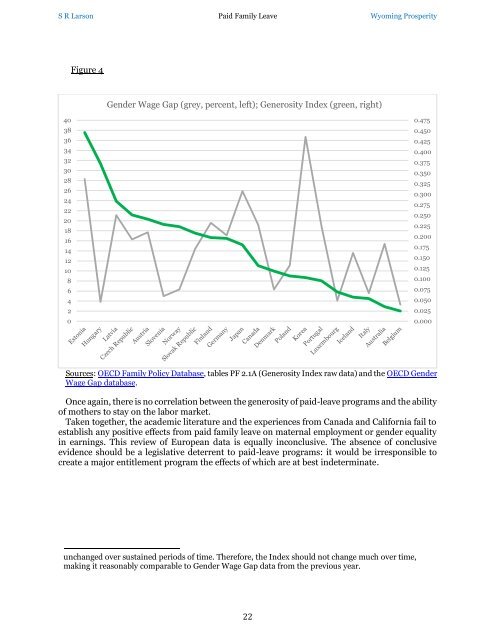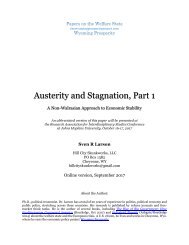Welfare State Paper 1 Paid Family Leave copy
You also want an ePaper? Increase the reach of your titles
YUMPU automatically turns print PDFs into web optimized ePapers that Google loves.
S R Larson <strong>Paid</strong> <strong>Family</strong> <strong>Leave</strong> Wyoming Prosperity<br />
Figure 4<br />
Gender Wage Gap (grey, percent, left); Generosity Index (green, right)<br />
40<br />
38<br />
36<br />
34<br />
32<br />
30<br />
28<br />
26<br />
24<br />
22<br />
20<br />
18<br />
16<br />
14<br />
12<br />
10<br />
8<br />
6<br />
4<br />
2<br />
0<br />
0.475<br />
0.450<br />
0.425<br />
0.400<br />
0.375<br />
0.350<br />
0.325<br />
0.300<br />
0.275<br />
0.250<br />
0.225<br />
0.200<br />
0.175<br />
0.150<br />
0.125<br />
0.100<br />
0.075<br />
0.050<br />
0.025<br />
0.000<br />
Sources: OECD <strong>Family</strong> Policy Database, tables PF 2.1A (Generosity Index raw data) and the OECD Gender<br />
Wage Gap database.<br />
Once again, there is no correlation between the generosity of paid-leave programs and the ability<br />
of mothers to stay on the labor market.<br />
Taken together, the academic literature and the experiences from Canada and California fail to<br />
establish any positive effects from paid family leave on maternal employment or gender equality<br />
in earnings. This review of European data is equally inconclusive. The absence of conclusive<br />
evidence should be a legislative deterrent to paid-leave programs: it would be irresponsible to<br />
create a major entitlement program the effects of which are at best indeterminate.<br />
unchanged over sustained periods of time. Therefore, the Index should not change much over time,<br />
making it reasonably comparable to Gender Wage Gap data from the previous year.<br />
22



